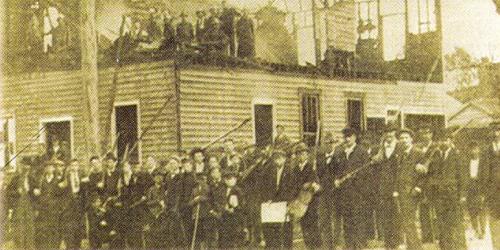Wilmington Insurrection of 1898
Share
Explore Our Galleries
Breaking News!
Today's news and culture by Black and other reporters in the Black and mainstream media.
Ways to Support ABHM?
From Wikipedia
The Wilmington Insurrection of 1898, also known as the Wilmington Massacre of 1898 or the Wilmington Race Riot of 1898, occurred in Wilmington, North Carolina on November 10, 1898 and following days; it is considered a turning point in North Carolina politics following Reconstruction.

Originally labeled a race riot, it is now termed a coup d’etat, as white Democratic insurrectionists overthrew the legitimately elected local government, the only such event in United States history.
In the Wilmington Insurrection, two days after the election of a white mayor and biracial city council, Democratic white supremacists illegally seized power from the elected government. More than 1500 white men participated in an attack on the black newspaper, burning down the building. They ran officials and community leaders out of the city, and killed many blacks in widespread attacks, but especially destroyed the Brooklyn neighborhood. They took photographs of each other during the events.
The Wilmington Light Infantry (WLI) and federal Naval Reserves, told to quell the riot, used rapid-fire weapons and killed several black men in the Brooklyn neighborhood. Both black and white residents later appealed for help after the riot to President William McKinley, who did not respond. More than 2,000 blacks left the city permanently, turning it from a black-majority to a white-majority city.

In the 1990s, a grassroots movement arose in the city to acknowledge and discuss the events more openly, and try to reconcile the different accounts of what happened, similar to efforts in Florida and Oklahoma to recognize the early 20th-century race riots of Rosewood and Tulsa, respectively. The city planned events around the insurrection’s centennial in 1998, and numerous residents took part in discussions and education events.
In 2000 the state legislature authorized a commission to produce a history of the events and to evaluate the economic impact and costs to black residents, with consideration of reparation for descendants of victims. Its report was completed in 2006.
Read more here.
Discover more about Reconstruction.
Comments Are Welcome
Note: We moderate submissions in order to create a space for meaningful dialogue, a space where museum visitors – adults and youth –– can exchange informed, thoughtful, and relevant comments that add value to our exhibits.
Racial slurs, personal attacks, obscenity, profanity, and SHOUTING do not meet the above standard. Such comments are posted in the exhibit Hateful Speech. Commercial promotions, impersonations, and incoherent comments likewise fail to meet our goals, so will not be posted. Submissions longer than 120 words will be shortened.
See our full Comments Policy here.









This is all news to me and I am a women of a certain age
what is the reason for me not learning this in high school?
Sadly, few Americans of any background learn about the more tragic events in US history, even though we are all shaped by these events as well as the more uplifting ones. Filling in those gaps is one of the primary goals of this museum. Thanks for visiting and for commenting!
I feel the same way! I was born in the 60’s ,& I remember being sent to the principals office, simply because I asked , where are all the black people in the history books that we are reading? Never Forgot that. I told my children about that now . as I learn things, I should’ve learned back then. I feel happy and cheated at all at the same time.
what about Alexander Manley-what was his role?
Alex Manley, according to this article, was one of thousands run out of town during the insurrection.
Those empowered to write our history books gloss over the tragedies perpetrated by much of the ruling class since the immigrants first came to these shores and committed genocide against the indigenous people. While the monstrosities were not committed by all immigrants, those in power soon learned that an economy built on stolen land and on stolen, enslaved human beings would become a force to be reckoned with in the world. They sought to justify this by using propaganda against those they stole from, and their descendants continue to write the history of the victors from their perspective. They want our children to grow up proud of this country’s accomplishments and unaware of the corrupt means by which they were attained. No one is all good or all bad. There were many good people trying to pull this country in a morally supportable direction, and still do. Propaganda still exists. The challenge is to separate truth from lies or half-truths and teach the whole truth about our country’s past, warts and all.
[…] was not an isolated incident is shown by the Wilmington, North Carolina Massacre of November 1898 (Wilmington Insurrection of 1898 – America’s Black Holocaust Museum (abhmuseum.org); America’s Only Successful Coup d’Etat Overthrew a Biracial Government in 1898 – HISTORY) […]